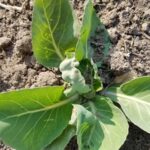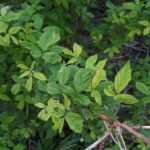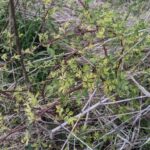This time of year, my email inbox and phone text messages are filled with ugly photos of fruit and vegetable crops affected by suspected herbicide exposure. Sometimes the symptomology points toward a clear cause and effect, but most of the time the answer is not so clear-cut. Here are a couple recent examples:
Cupping and discolored cabbage leaves:
I recently received grower photos from a cabbage field with plants displaying cupping of new leaves and discoloration on older leaves (Figure 1). The grower believed the symptoms to be the result of a micronutrient deficiency, but wanted to rule out carryover from herbicides applied in last year’s corn crop. In scenarios like this one, I find that it can be helpful to look at plants from other fields or farms to draw comparisons. In some cabbage cultivars leaf cupping is a common occurrence. In this case, I compared the grower photos with ‘Tiara’ cabbage grown at the Purdue Student Farm (Figure 2), which were planted into a field with no recent history of herbicide application. The leaf cupping symptoms were similar between the two fields, but the discolored older leaves were unique to the grower’s cabbage. Soil and plant tissue samples from symptomatic and asymptomatic portions of the field can be used to rule out nutrient deficiency. If nutrient analyses do not reveal any clues, it is possible that herbicide carryover is playing a role in the grower-observed crop symptoms.
- Photo by: Oliver Book
- Photo by: Chris Adair
Leaf spotting and chlorosis on strawberry and red raspberry:
The pattern of crop injury is an excellent indicator of if herbicides are at fault and their source. Injury that matches the width of a spray boom suggests a potential herbicide misapplication. Strips of injury or injury at field edges can indicate overlapping herbicide applications, resulting in an excessive application rate. Injury at the start of a sprayer pass can indicate tank contamination or insufficient sprayer agitation. In the scenario below, I document a confirmed case of physical herbicide drift.
In mid-April I noticed a neighboring farmer spraying his soybean field along our shared property line. The next day, speckled leaves appeared across my small farm. A week later, strawberry (Figure 3) and red raspberry plants (Figure 4) demonstrated chlorotic (yellow) leaves on their newest growth. When I contacted the neighboring farmer, he told me that Zidua® PRO and glyphosate were applied. Zidua® PRO is a premix of imazethapyr, saflufenacil, and pyroxasulfone. The saflufenacil resulted in the leaf spotting soon after application, but the chlorosis was the result of the glyphosate component of the tank-mix. It is very common for systemic herbicides, like glyphosate, to take several days to result in symptoms of sensitive plants. Weeds growing in the field edge were highly symptomatic with gradually decreasing severity as the distance from the soybean field increased (Figure 5). Plants up to 50 feet in the downwind direction also exhibited glyphosate injury, including a wild rose growing in a fencerow (Figure 6). In this instance, a clear pattern existed in space and time that pointed toward a herbicide drift event that was later confirmed by the herbicide applicator.
- Photo by: Stephen Meyers
- Photo by: Stephen Meyers
- Photo by: Stephen Meyers
- Photo by: Stephen Meyers
Additional Resources:
For a quick reference of corn and soybean herbicide rotation restriction information, turn to pages 68 and 69 of the 2023 Midwest Vegetable Production Guide: Corn-and-Soy-Herbicide-Rotation-Restriction-Tables.pdf (mwveguide.org)
To register your specialty crop fields with Drift Watch, visit: DriftWatch – Home
Weed scientists at Purdue and other midwestern universities put together a series of herbicide drift bulletins available here: Dicamba and 2,4-D Fact Sheet Series | Herbicide-Drift Risk Management for Specialty Crops (ohio-state.edu)
To file an off-target herbicide complaint, use this form from the Office of Indiana State Chemist: complainant_form.pdf (purdue.edu). The current form allows those filing a complaint to indicate if they would like to document the incident only or pursue potential enforcement actions.
To learn more about properly removing herbicide residues from agricultural application equipment, visit Removing Herbicide Residues from Agricultural Application Equipment | Purdue Pesticide Programs
To submit an ugly plant (or insect) for diagnosis, visit the Purdue Plant and Pest Diagnostic Lab here: Plant & Pest Diagnostic Lab (purdue.edu)





